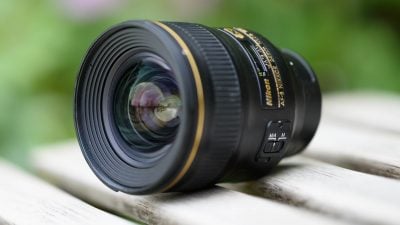Nikon 24mm f1.4G review
-
-
Written by Thomas
Quality
Longitudinal Chromatic Aberration and focus shift
With lenses offering an aperture of f2.8 or larger I test for longitudinal CA (loCA, a.k.a. “axial color” or “bokeh CA”). The Nikon shows some magenta coloration in the foreground (left) and greenish hues in the background (right). This also shows up in real-life shots but is by comparison pretty moderate. By f4.0 the effect is gone. The test also revealed that there is some focus shift towards the background.
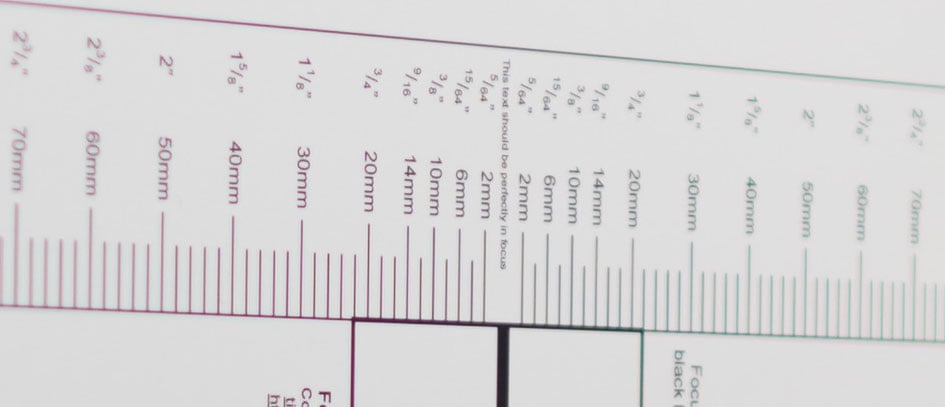
Above: Nikon 24/1.4G Longitudinal Chromatic Aberration (loCA) at f1.4. 100% crop, left = foreground, right = background
Sharpness and contrast
Let’s have a look at the theoretical performance of the Nikon lens first compared to the performance of the Sigma 24mm f1.4 Art:
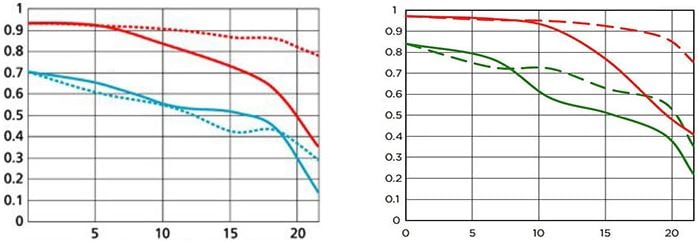
Above: MTF of Nikon 24/1.4G (left), Sigma 24/1.4 Art (right), both at f1.4
These charts show the lens-performance at the largest aperture. Higher values are better and the closer the dotted and the continuous lines of each color are together the less astigmatism (= resolution depends on the orientation of the test-pattern) the lens has. The x-axis displays the distance from the optical axis (=center of the sensor) in mm. I’ll show you the real-life performance at 4 mm (center), 13 mm (DX-corner), and 20 mm (FX-corner) on a D810.
From the charts, the Sigma should perform slightly better than the Nikon. The Sigma starts at a higher contrast in the center but has a more pronounced drop towards the borders of the DX image-circle (14mm) with another drop towards the corners of the FX sensor. Its values still stay above those of the Nikon. Only the spread between sagittal and meridional performance is larger indicating higher astigmatism of the Sigma than the Nikon – at least on paper. But let’s see how this theoretical performance translates into real life results in the sharpness test based on Siemens-stars.
What follows are near-center results (first column) followed by DX-corner results and FX-corner results on a D810. The D810 results from the DX-corner should be a very good approximation for performance on a 16MP DX sensor (like the D7000), because the pixel-pitch of both sensors are the same. But differences in the AA-filter and micro-lens-design of a D810 and a D7000 might yield different end-results.
Processing was done in Lightroom 6.3 from RAW at Camera Standard settings. Noise-reduction is set to 0, sharpening to 35/0.5/36/10, with no extra tone, color, or saturation-adjustment. White-balance was adjusted to a neutral white and I did some exposure compensation to make the brightness match. CA-removal is ON.
The following are all 100% crops!
Nikon 24/1.4G on Nikon D810; 100% crop from center, DX-corner, FX-corner

Above: 24mm, f1.4

Above: 24mm, f2.0

Above: 24mm, f2.8

Above: 24mm, f4.0

Above: 24mm, f5.6

Above: 24mm, f8.0

Above: 24mm, f11
These 100% crops directly from a 36MP D810 sensor shows a fine performance of this lens. At f1.4 the center is very sharp, the DX-corner is slightly soft, and the FX-corner shows quite some detail but is hazy and shows coma. Focus was optimized separately for each crop as there is some slight field-curvature. Stopping down to f2.0 improves the contrast of the center and DX-corner visibly while the FX-corner needs stopping down to f2.8 to lose its haziness. Diffraction is softening the image from f11 on. Distortions are pretty low for such a wide-angle lens.
Following is a direct comparison of the Nikon (1st row) to the Sigma 24mm f1.4 Art (2nd row) and the Samyang 24mm f1.4 (last row) at f1.4:

Above: Nikon 24/1.4G at 24mm, f1.4

Above: Sigma 24/1.4 Art at 24mm, f1.4

Above: Samyang 24/1.4 at 24mm, f1.4
In the center the Sigma produces the sharpest image followed by the Nikon and the Samyang. In the DX-corner the order is reversed: the Samyang leads followed by the Nikon. The Sigma is only third place. In the FX-corner all three lenses perform very similarly with a slight advantage for the Sigma. Regarding field curvature at this distance: The crops of the Samyang were all taken from the same shot while both the Nikon and the Sigma needed some slight focus optimization indicating a curved field.
Performance at long distances
The Siemens-star test-targets are shot at a distance of 40x focal length. But performance of lenses also depends on the shooting distance. Therefore I do another series of test-shots of a landscape dubbed the “Unremarkables” where you can measure distances in km, not meter. I use this scene to show you how the lenses perform when almost everything is at infinity. I set White Balance to a standard daylight value to make them comparable across lenses shot at the same day and also try to make exposure comparable. There’s no tinkering with vignette-control so you see it here as it is produced by the lens. Focus was manually acquired at the largest aperture in live-view and not changed for other apertures.
You can click on the image to access the large original. Please respect our copyright and only use those images for personal use.
The main image shows the complete scene at maximum aperture to give you an impression of the angle of view and to judge vignetting. This is followed by one row of 100% crops from f1.4 to f8 each from the middle, the DX-corner and the right FX-corner. The atmosphere was pretty hazy on that morning but I had no other chance to shoot all three 24/1.4 lenses at the same time.
You can access the respective shots up to f11 via the links beneath the main image.
Nikon 24/1.4G shot with Nikon D810
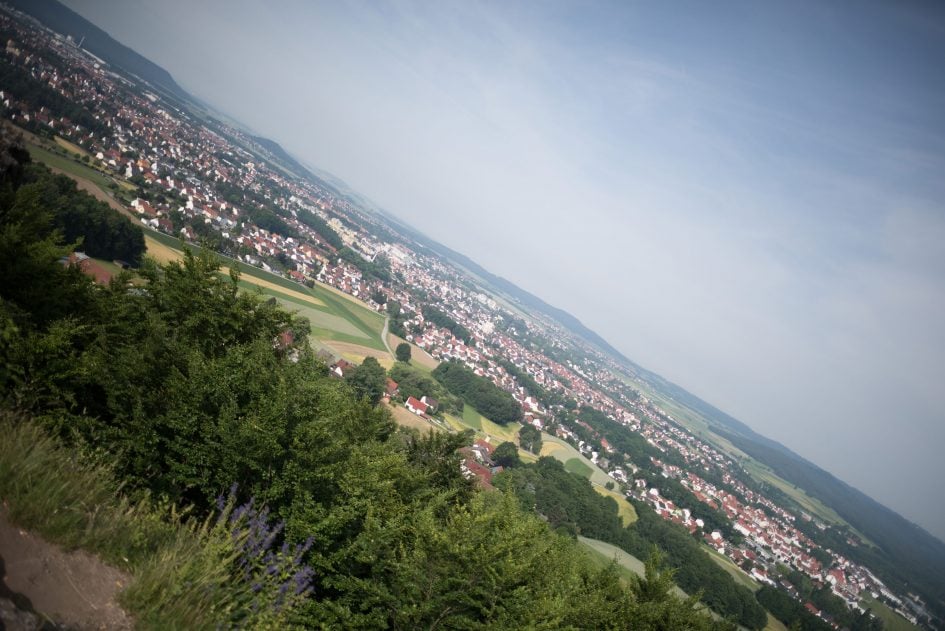
Above: at 24mm, f1.4; also available at f2.0, f2.8, f4.0, f5.6, f8.0, f11

Above: 24mm, f1.4; 100% crop from center, DX-corner, FX-corner

Above: 24mm, f2.0; 100% crop from center, DX-corner, FX-corner

Above: 24mm, f2.8; 100% crop from center, DX-corner, FX-corner

Above: 24mm, f4.0; 100% crop from center, DX-corner, FX-corner

Above: 24mm, f5.6; 100% crop from center, DX-corner, FX-corner

Above: 24mm, f8.0; 100% crop from center, DX-corner, FX-corner
Performance is good already at f1.4. Stopping down to f4.0 improves sharpness and contrast to very good values across the sensor and and results in very low vignetting. I shot the same scene within minutes with the Sigma 24/1.4 Art and the Samyang 24/1.4 for comparison:

Above: Nikon 24/1.4G at f1.4; 100% crop from center, DX-corner, FX-corner

Above: Sigma 24/1.4 Art at f1.4; 100% crop from center, DX-corner, FX-corner

Above: Samyang 24/1.4 at f1.4; 100% crop from center, DX-corner, FX-corner
Of the three lenses the Sigma is the best in the infinity-shot wide open although it seems to have a bit more vignetting than the Nikon. The Samyang could not translate its good performance at the close-up test to this landscape-shot. But mind you: its performance in the FX-corner at f1.4 is still amazing.
Vignetting
To make it easier to compare light fall-off in the corners of a full-frame sensor I’ve arranged a series of three shots each with the Nikon (1st row), the Sigma (2nd row), and the Samyang (last row) at different apertures. From left to right: f1.4, f2.0, and f2.8:

Above: Nikon 24/1.4G at f1.4, f2.0, f2.8

Above: Sigma 24/1.4 Art at f1.4, f2.0, f2.8

Above: Samyang 24/1.4 at f1.4, f2.0, f2.8
As you can see, the differences under controlled conditions are minimal.
Rendering of point-light sources at night-shots
Night-shots pose a different challenge for lenses as the contrast is even higher than under bright sun and point-light sources can reveal some weaknesses such as coma, haloing and color-aberrations that do not show up as prominently in other test-shots. The 100% crops below the main image show the effect of coma in the FX corner of the Nikon at various apertures. It is very strong wide open but from f4.0 the effect is negligible:
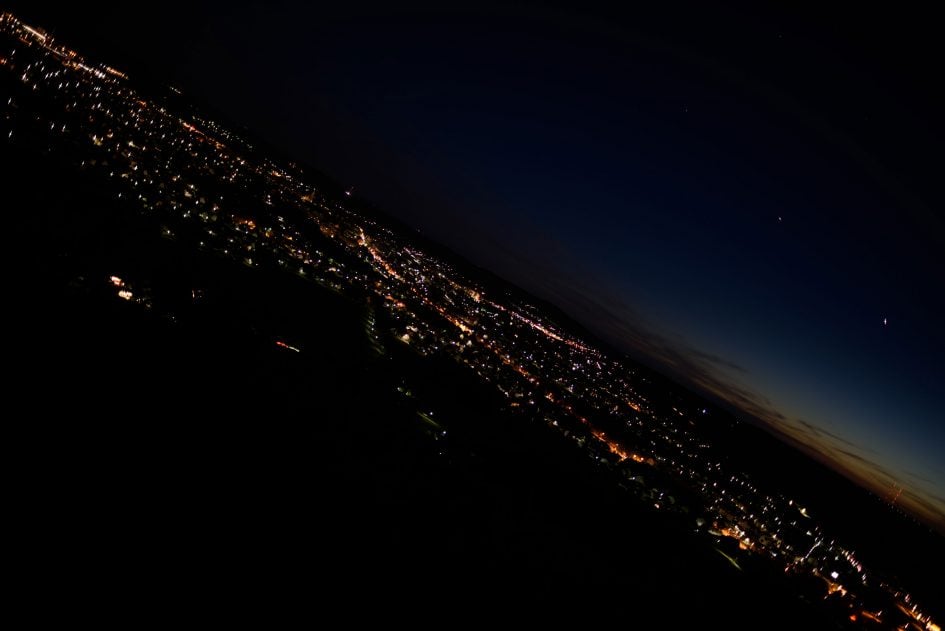
Above: Nikon 24/1.4G at f1.4; also available at f2.0, f2.8, f4.0, f5.6

Above: Nikon 24/1.4G; FX-corner at f1.4 (left), f2.8 (middle), f4.0 (right)
The following crops show the performance from the Sigma and the Samyang:

Above: Sigma 24/1.4 Art; FX-corner at f1.4 (left), f2.8 (middle), f4.0 (right)

Above: Samyang 24/1.4; FX-corner at f1.4 (left), f2.8 (middle), f4.0 (right)
The Samyang produces very little coma, the Nikon is the worst and the Sigma is somewhere in-between.
Rendering of out-of-focus point-light sources
This test is for the rendering of point-light sources in an out-of-focus background. The circle of confusion that is produced by this test is pretty indicative of Bokeh performance (in the background) and light fall-off. Ideally the out-of-focus image of the point-light is evenly lit and perfectly circular, with no “onion-rings”, and without coloration. Large aperture lenses normally produce an effect known as “cat’s eye” the further away from the optical axis the point-light is projected. This is due to optical vignetting in the lens barrel when light enters the lens from an angle.
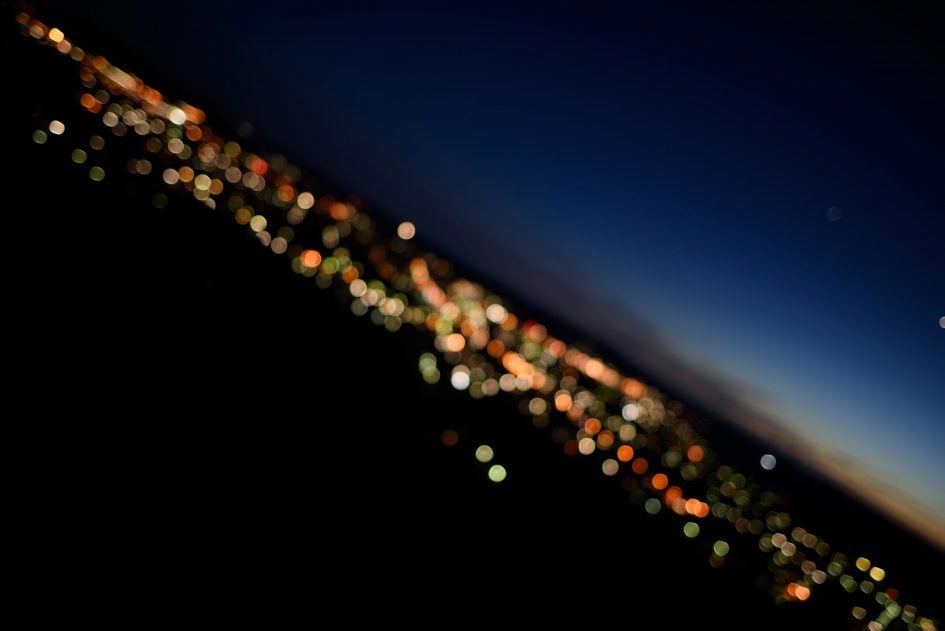
Above: Nikon 24/1.4G at f1.4; also available at f2.0, f2.8, f4.0, f5.6

Above: Nikon 24/1.4G at f1.4. 50% crop from center, DX-corner, FX-corner.
As the 50% crops above show: The Nikon 24/1.4 Art produces not the fattest circle of confusion. But that was not to be expected with a 24mm lens. It exhibits only slight onion rings but the light-distribution across the circle is is a bit uneven. There is some (green) outlining becoming more pronounced the further away you look from the center and the “Bokeh balls” become also seriously squeezed towards the FX-corner. There seems to be no clipping from the mirror-box. Let’s see how the Sigma and Samyang compare:

Above: Sigma 24/1.4 Art at f1.4. 50% crop from center, DX-corner, FX-corner.

Above: Samyang 24/1.4 at f1.4. 50% crop from center, DX-corner, FX-corner.
The Nikon produces slightly bigger Bokeh balls than the Sigma but it also shows a more intense outlining in the center and the borders of the DX image-circle which is also colored green from the stronger longitudinal CAs. The circles of confusion (coc) produced by the Samyang is nothing I’ve ever seen before: It is smaller than from the other two lenses and does exhibit some onion-rings but overall the inner structure of the Bokeh ball is freckled. This makes the coc in the center look more fluffy than from the competition – which is a good thing. But it may also be the reason that the Samyang is not the most contrasty lens in the center.
Now let’s see how this analysis of out-of-focus point-light sources translates into Bokeh-performance shooting a book-shelf.
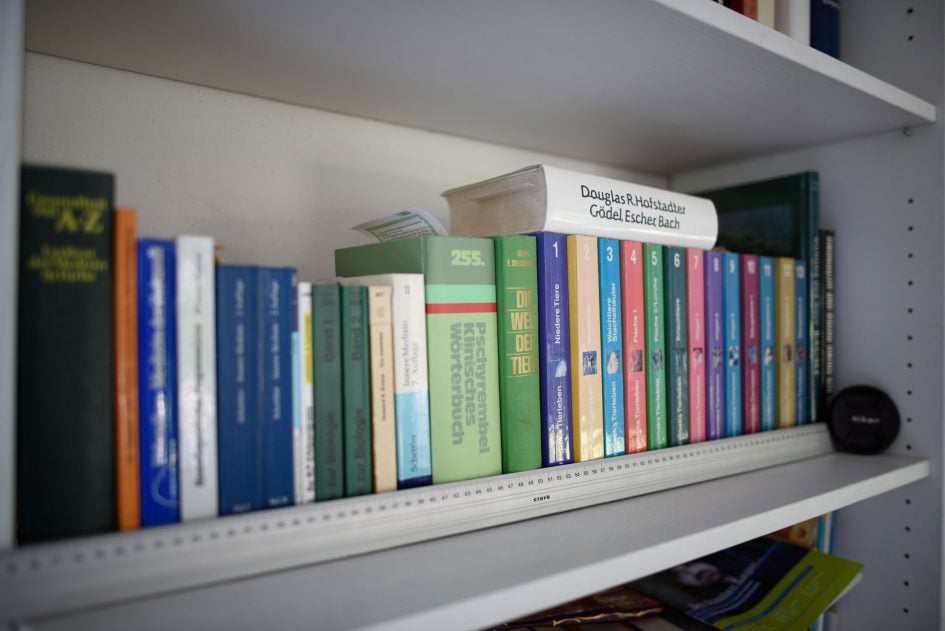
Above: Nikon 24/1.4G at f1.4; also available at f2.0, f2.8, f4.0, f5.6

Above: Nikon 24/1.4G at f1.4. 50% crop from foreground, middle-ground, background
The (less important) foreground is nicely blurred. But the middle-ground suffers a bit from loCA coloring the letters green. And the background shows some outlining which makes the Bokeh a bit nervous. Let’s see how the Sigma and Samyang compare:

Above: Sigma 24/1.4 Art at f1.4. 50% crop from foreground, middle-ground, background

Above: Samyang 24/1.4 at f1.4. 50% crop from foreground, middle-ground, background
The foreground is best with the Sigma followed by the Nikon and the Samyang. The middle-ground shows slightly greenish coloration from the Nikon and the Samyang. And in the background the Samyang comes up as the surprise winner: it nicely blurs the letters on the back of the books, while the Nikon perhaps has a little less outlining than the Sigma but still looks nervous in comparison.
Flare/ghosting
Catching a strong light-source shining directly into the lens is a major risk with wide-angle lenses – even with the lens-hood attached. That could produce strange colorful ghosts-images or reduce contrast considerably through flare and glare. The appearance of flare and ghosting depends on factors like the aperture and the angle of the light hitting the lens. So to judge the proclivity of the Nikon for these artifacts I went through a series of well calculated shots against a strong light source to provoke glare and ghosting.
The results are not as good as one would expect from the Nano-coating: There were many instances of flare and some ghosting with the light-source inside as well as outside the frame. See two examples below:
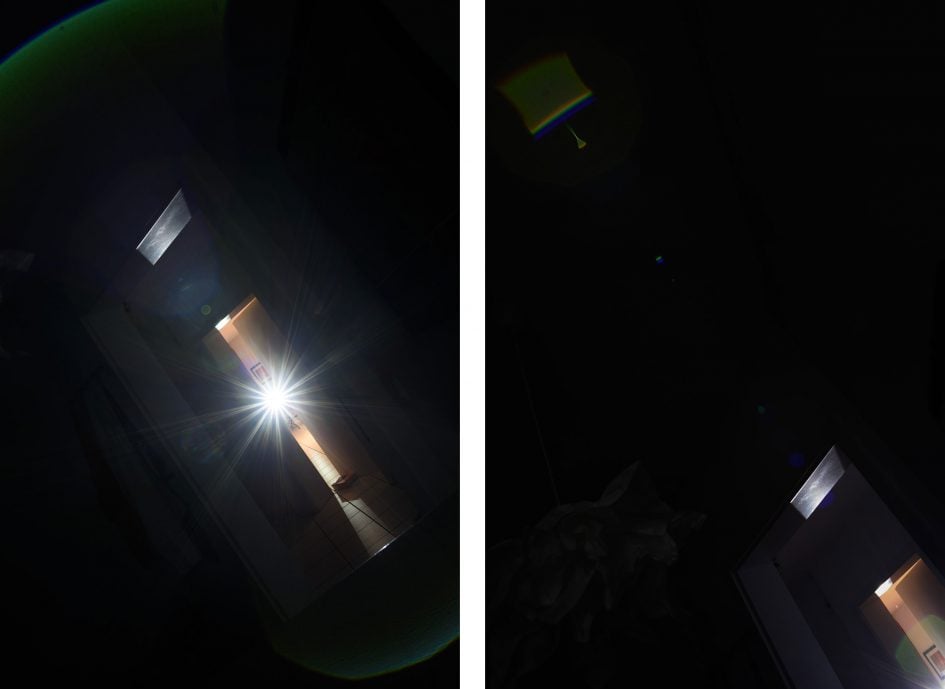
Above: Strong light hitting the Nikon 24/1.4G from inside (left) and outside (right) of the image frame at f8.0
So you have to carefully watch out for these effects.




